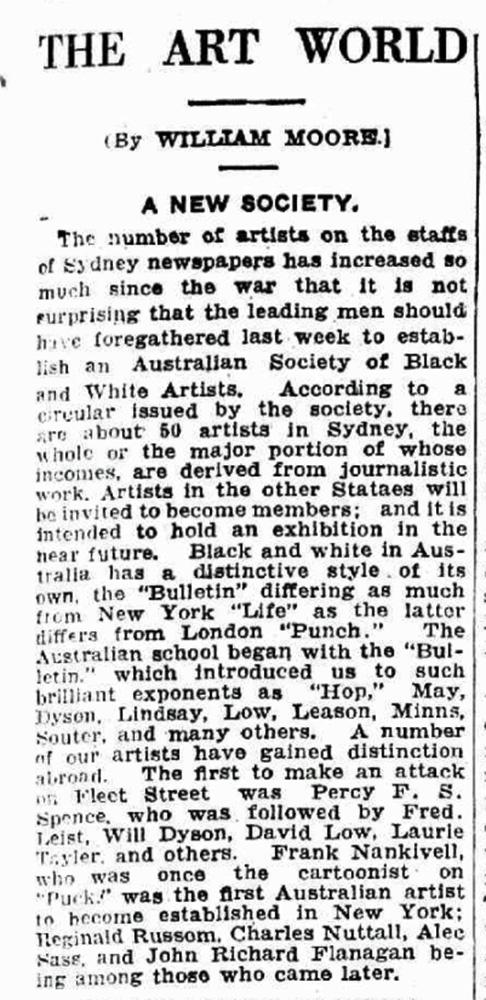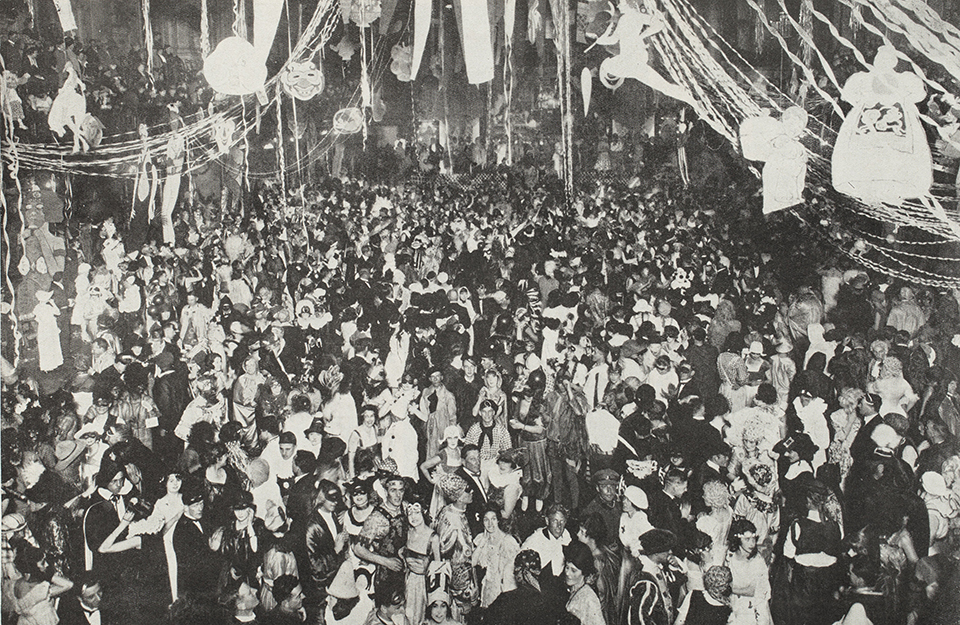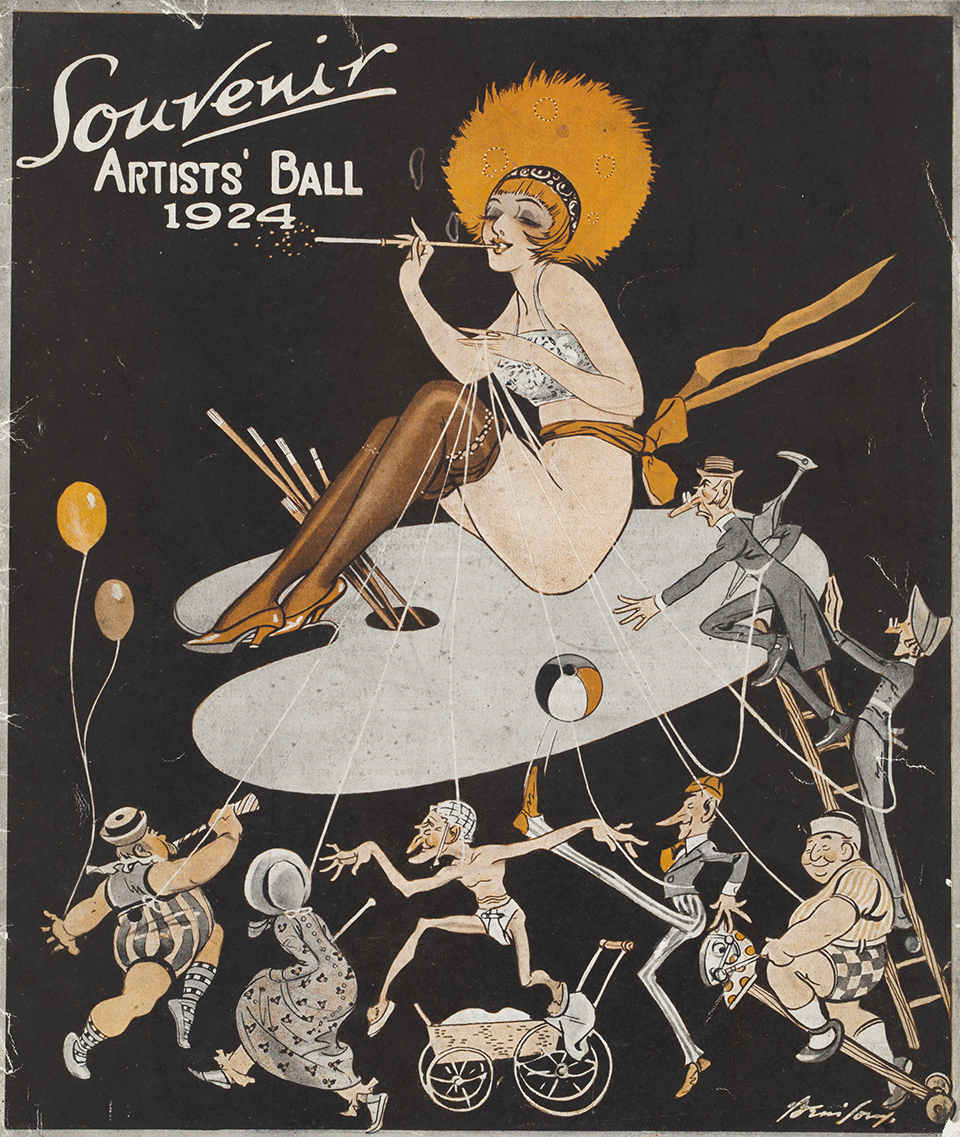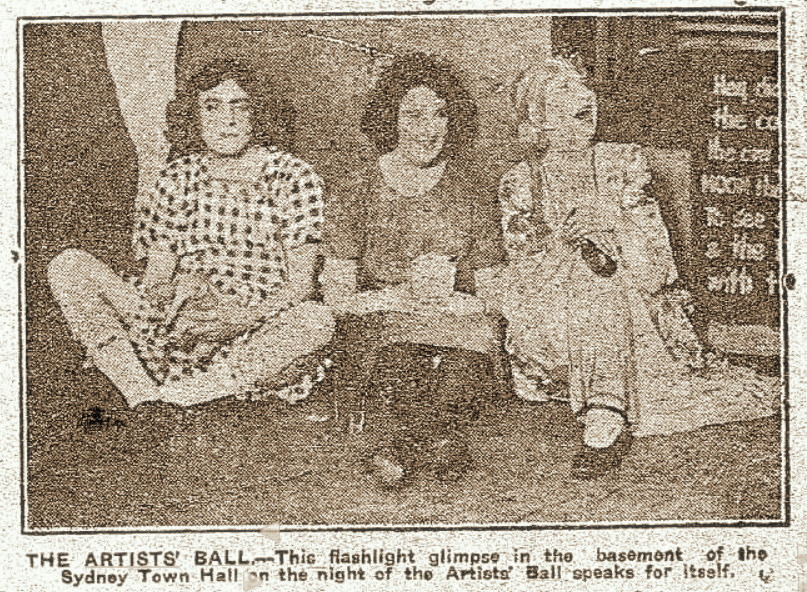The Dictionary of Sydney was archived in 2021.
A Short History of the Black and White Artists' Club
Citation
Persistent URL for this entry
To cite this entry in text
To cite this entry in a Wikipedia footnote citation
To cite this entry as a Wikipedia External link
A Short History of the Black and White Artists' Club
[media]On 17 July 1924, 24 cartoonists and one poet met to form the Society of Australian Black and White Artists. It was an unusual assembly as they mostly met in pubs and this gathering was in the studio of a cartoonist, Gayfield Shaw [1]. Shaw's studio was on the first floor of the Royal Arcade which linked George and Pitt streets between Park and Market streets. [2] It was not far from the Sydney Town Hall and only a few blocks away from 126–130 Phillip Street where Smith's Weekly and The Daily Guardian offices were, and where many of the founding members of the society worked. [3]
Cecil Hartt was elected the founding president. He was considered to be as handy with a glass as he was with a pencil. Hartt had worked as a freelance cartoonist in Sydney before World War I and had been wounded at Gallipoli. On returning home he learnt about Smith's Weekly when gossiping in a pub [4]. He became the first artist to join the staff. Despite the fact that there had been newspapers around for about 500 years, the Society of Australian Black and White Artists was the first association of newspaper artists in the world. [5]
In the 1880s, after The Bulletin had been founded, artists had been attracted to Sydney to sell cartoons and illustrations to the paper. Most were freelancers who worked in small studios and only came into town on Saturdays to get paid. The Bulletin would hand over cash to anyone who arrived in the office and showed a tear sheet with his or her work on it. Naturally enough, any pub close to the office was a popular destination for the Saturday walk for the writers and cartoonists with money in their pockets. [6]
'Beerhemians'
Unlike The Bulletin, when Smith's Weekly started in 1919 it employed many cartoonists who worked in the art department. The paper also accepted work from freelance contributors. All liked a drink and they drank often. During the week they mostly drank as a Smith's Weekly collective near the office. On Saturdays they would find their way into drinking establishment filled with all the cashed-up freelancers. Many of the cartoonists would have been involved in discussions about the artists' balls. One of the topics was how the workload had shifted from artists in little studios to artists in large art departments.
One of the popular destinations for drinking was the narrow cobble-stoned Wynyard Lane that ran parallel to George Street. It contained three old-fashioned hotels with their bars concentrated in less than a hundred yards (approximately 90 metres). There was also Pfahlert's Hotel, which was demolished in the 1960s, and the Cafe Francais, and in all the bars there was beer and counter lunches [7]. The Press Club, which was established in 1911 at 51 Elizabeth Street and moved to 5 Hamilton Street in 1923, was another popular watering hole.
For many years, many of the artists in Sydney had been known under the collective title of 'bohemians'. They were happy to be considered different from non-artistic types but they were not real bohemians. Most had jobs or ran their own businesses and would have been hard to spot in a crowd of non-bohemians. There was one difference: they did drink far more than what would have been considered average. Consequently Henry Lawson called them 'beerhemians'. Disregarding the bohemian life style of unconventionality, for many years they even held large well-managed artists' masquerade balls.
Artists' balls
[media]The ball in the Sydney Town Hall in 1922 was jazz-themed. It seems to have gone over very well. May Gibbs and her husband J O'Kelly attended and enjoyed the night. Their friend Frank De Groot conducted the charity auction, which raised over £3000 [8]. Newspaper reports described it as 'indisputably the most spectacular dance that has taken place in the city'. [9] De Groot acted as auctioneer again in 1923, however there were some problems. Kelly described it as 'a disgusting affair' and he and Gibbs resolved not to attend the 1924 event.
[media]The 1924 Artists' Ball was intended to be like its predecessors, only better. The Sydney Lord Mayor, Alderman David Gilpin, said he knew the 1924 ball would be a 'humdinger' as many of the Town Hall staff had worked overtime in order to allow it to be held. It was styled on a 'Back to Childhood' theme and the majority of those present donned rompers. The event attracted between 2,000 and 3,000 revelers and hundreds of others were turned away unable to purchase tickets at any price.
Newspapers of the day reported the most notable costume of the evening was that donned by the Smith's Weekly cartoonist, George Finey. He wore a baby's napkin pinned in quite an orthodox way with a 2ft (61 centimetre) safety pin. He also wore a pair of white booties and carried a feeding bottle containing brown frothy milk. Although merrymaking in the main ballroom had started in moderation, by midnight it had evolved into a riot. In the basement, girls and men were kissing while other drunken men with tipsy girls were trying to dance. There were newspaper accounts of police officers forcing open rooms in which they found couples. It was left to readers' imaginations as to why the rooms needed to be forced open or what the enclosed couples might have been doing.
[media]The next day council staff had to assist the police in clearing the hall and getting the sick and wounded to hospital. Soon after Sydney Council received a report on how the evening had descended into a bacchanalia. The event was considered so outrageous that further artists' balls were banned from the Sydney Town Hall. There were even calls from many in the community to have any further artists' balls banned altogether.
The council ban and community protests had little effect on future artist's balls. The artists just ignored them. What did happen was a change of venue. There was one other difference: for a number of years the Society of Artists and the Society of Black and White Artists both held balls.
Artistic differences
While the balls were popular with many members of society – only the more sedate members of the public condemned them – they were the cause of friction between sections of the art community in Sydney. It was not the risqué nature of these balls that caused the friction, it was money. The cartoonists believed they were doing all the work – which was considerable – to enable these balls to take place, and other artists were making all the decision regarding the spending of the very substantial profits.
It was not uncommon for there to be splits and new groupings in art societies in Sydney. They happened regularly. The Society of Artists had itself split from the Art Society of New South Wales in 1895 [10]. Most of the splits had been caused by philosophical differences but times had changed and so too had employment conditions for cartoonists.
Towards the middle of 1925, the attention of the Sydney newspapers was on the forthcoming visit of the American fleet to Australia. It was big news and was due to arrive in July. The cartoonists decided to capitalise on the event and put together a 48-page souvenir magazine to celebrate the fleet's arrival.[11] It contained 45,000 men on 37 warships (including the flagship) three battleships that visited Melbourne and eight battleships which all sailed into Sydney Harbour. The slightly smaller than A4 sized magazine – with a colour cover – contained cartoons by 25 cartoonists and 22 advertisements, many of which were drawn by the cartoonists. It sold for a shilling and made a profit. The publication also promoted the next black and white ball stating it was to be similar to the earlier bohemian style artists' balls.
The ball was held on 29 September 1925 in Sydney's Palais Royal. Seventy-five percent of the proceeds were given to the Children's Hospital, forming the nucleus of a £10,000 appeal to assist in the building of additions to the institution. It was fancy dress and only 1,100, £1 tickets were made available. There had been another ball the week before, on 24 September. It was conducted by the Society of Artists and was held at the Ambassador Hotel. It was a bigger event than the one the cartoonists held. Both events seemed to have gone off well and there was a clear division with the cartoonists attending their ball and other artists attending the Society of Artists Ball.
Stanley Awards
Since it was formed, the Australian Society of Black and White Artists has hosted over 20 Black and White Artists' balls with the last being the Atomic Ball held in 1946. The late 1940s were difficult times for Australia and most cartoonists were doing it tough. Many of the newspapers which had existed in the 1920s had disappeared. When Smith's Weekly folded in 1950 [12], the The Bulletin was just a shadow of the once great publication it had been.
For the best part of the next 25 years, the Black and White Artists' Club, as it was then called, restricted its activities to social events for members, with one minor exception: there was a successful retrospective exhibition of cartoons held in the Sydney Journalists' Club in 1964.
The membership increased and decreased over the years and by 1984 there were less members in the Black and White Artists' Club than there had been when the body was formed 60 years before. Rather than just fold, the members decided to expand. One-way of attracting new members to what had been a Sydney organization was to run national awards to promote cartooning. They approached The Bulletin about sponsoring the awards. The magazine was running around 50 cartoons a week and was enjoying a revival. A partnership was formed and in 1985 the first Stanley Awards were presented [13].
The Bulletin continued to sponsor the awards till 1993. With the number of cartoons being published in the magazine greatly diminished, and a declining circulation, the running of the awards night was handed back to the Australian Black and White Artists' Club. The Bulletin never went back to publishing large numbers of cartoons and folded in January 2008.
Over the past 30 years the membership of the Black and White Artists' Club or the Australian Cartoonists' Association (as it is now known) has hovered around 300. The Stanley Awards have continued with support from other sections of the publishing industry.
References
George Blaikie, Remember 'Smith's Weekly'?: A Biography of an Uninhibited National Australian Newspaper, Born 1 March 1919, Died 28 October 1950, Rigby, Adelaide, 1975
Vane Lindesay, Drawing from life: A History of the Australian Black and White Artists' Club, State Library of New South Wales Press, Sydney, 1994
Norman Lindsay, Bohemians of The Bulletin, Angus and Robertson, Sydney, 1973
Notes
[1] Vane Lindesay, Drawing from life: A History of the Australian Black and White Artists' Club, State Library of New South Wales Press, Sydney, 1994
[2] The arcade disappeared as the Hilton Hotel was built in the early 1960s
[3] Back then most of the other newspaper offices in Sydney would have only been a ten to fifteen minutes stroll away. The Evening News was close by at 168 Castlereagh Street – a building that became home to the Australian Women's Weekly just over a decade later. The afternoon paper, The Sun, was in 32 Castlereagh Street; The Sydney Morning Herald was on the corner of Pitt and Hunter streets; and its main competitor, The Daily Telegraph, was located at the corner of King and Castlereagh streets. The Bulletin was at 214 George Street between Dally and Alfred streets. The Australian and New Zealand Writers' and Artists' Year Book: A Directory for Writers, Artists and Photographers, Cecil Ringstad, Sydney, 1929
[4] Narromine News and Trangie Advocate, 20 June 1930
[5] Vane Lindesay, Drawing from life: A History of the Australian Black and White Artists' Club, State Library of New South Wales Press, Sydney, 1994
[6] Norman Lindsay, Bohemians of The Bulletin, Angus and Robertson, Sydney, 1973
[7] Kenneth Slessor, ' The Lane' in Frank C Johnson, Jack Lindsay and Kenneth Slessor (eds), The Vision Press, Sydney, 1923–24
[8] Maureen Walsh, May Gibbs, Mother of the Gumnuts, Angus and Robertson, Sydney, 1994
[9] Shirley Fitzgerald, Sydney: A Story of a City, City of Sydney, Sydney, 1999
[10] William Moore, The Story of Australian Art: From the Earliest Known Art of the Continent to the Art of Today, Angus and Robertson, London and Sydney, 1980
[11] U.S.A. fleet souvenir : being the first publication issued by the Society of Australian Black & White Artists, The Society, Sydney, 1925, Mitchell Library, State Library of NSW (ML Pam file/730-744)
[12] George Blaikie, Remember 'Smith's Weekly'?: A Biography of an Uninhibited National Australian Newspaper, Born 1 March 1919, Died 28 October 1950, Rigby, Adelaide, 1975
[13] Vane Lindesay, Drawing from life: A History of the Australian Black and White Artists' Club, State Library of New South Wales Press, Sydney, 1994
.






